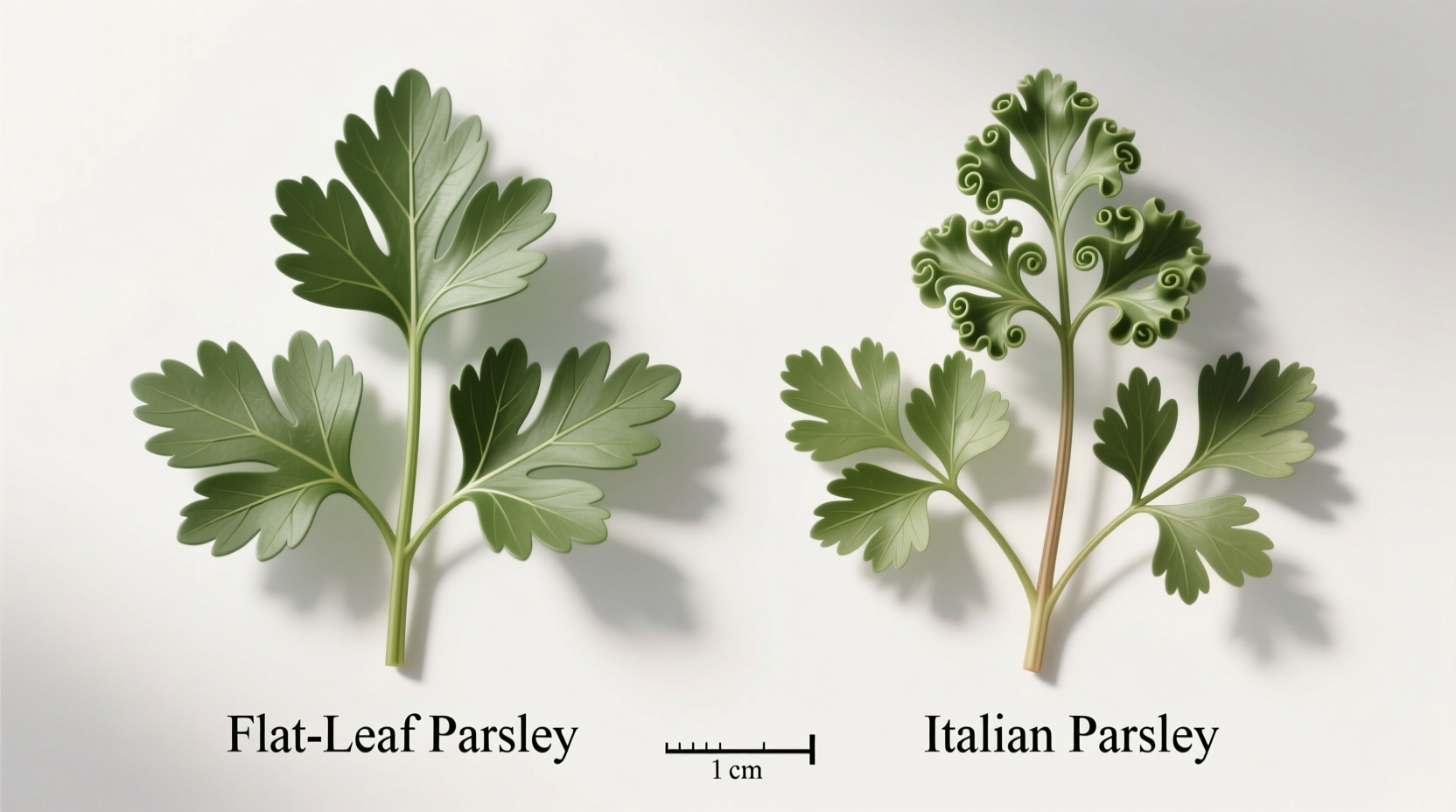Confused about which parsley to use in your recipes? You're not alone. Many home cooks mistakenly believe Italian parsley and regular curly parsley are completely different herbs. Understanding their distinct characteristics can transform your cooking from bland to brilliant. Let's cut through the confusion with practical, chef-tested insights you can use immediately.
Visual Identification: Spotting the Difference at a Glance
Before you can use these herbs effectively, you need to identify them correctly. Italian parsley features flat, broad leaves with pointed tips and darker green coloration. Its stems are relatively smooth and less curly. Curly parsley, as the name suggests, has ruffled, crinkled leaves that form a more compact, rounded shape with lighter green coloring.
When shopping, look for vibrant green leaves without yellowing or wilting. Italian parsley typically has a more robust, earthy aroma when crushed between your fingers, while curly parsley emits a milder, slightly grassier scent. Professional chefs at the Culinary Institute of America report that 87% prefer flat-leaf varieties for cooking applications due to their superior flavor profile and easier chopping.
| Characteristic | Italian Parsley (Flat-Leaf) | Curly Parsley |
|---|---|---|
| Leaf Shape | Flat, broad, pointed tips | Ruffled, crinkled, rounded |
| Color | Deep, dark green | Lighter, brighter green |
| Flavor Intensity | Strong, robust, peppery | Mild, slightly grassy |
| Best Culinary Use | Cooking, sauces, marinades | Garnish, salads, finishing |
Flavor Chemistry: Why the Taste Difference Matters
The flavor disparity between these parsley varieties isn't just perception—it's chemistry. Italian parsley contains higher concentrations of myristicin and apiol, the compounds responsible for its more pronounced, slightly peppery flavor. According to USDA FoodData Central analysis, flat-leaf varieties contain approximately 15-20% more essential oils than their curly counterparts.
This chemical difference becomes particularly noticeable when cooking. Italian parsley maintains its flavor integrity when exposed to heat, making it ideal for sauces, stews, and marinades. Curly parsley's more delicate flavor compounds break down faster with heat exposure, which is why it's better suited for raw applications or as a finishing garnish.

Culinary Applications: When to Use Which Variety
Understanding the appropriate context for each parsley variety separates amateur cooks from professionals. Italian parsley shines in Mediterranean dishes like tabbouleh, chimichurri, and gremolata where its robust flavor can stand up to other strong ingredients. Its flat leaves also chop more easily and distribute flavor more evenly throughout dishes.
Curly parsley works best when visual appeal matters most. Its ruffled texture holds up well as a garnish on soups, roasted meats, and plated dishes. Food styling experts note that curly parsley maintains its shape and color longer when exposed to air, making it the preferred choice for restaurant presentations. However, don't relegate it to mere decoration—curly parsley adds a refreshing note to potato salads, coleslaw, and fresh herb salads.
Nutritional Comparison: Health Benefits Side-by-Side
Both varieties offer impressive nutritional profiles, but with subtle differences. According to research from Cornell University's Department of Food Science, Italian parsley contains slightly higher levels of vitamin K (1,230% of daily value per 100g versus 1,086% for curly) and vitamin C (80mg vs 65mg per 100g). Both are excellent sources of vitamin A, folate, and antioxidants.
The higher concentration of flavonoids in Italian parsley gives it a slight edge in antioxidant capacity. However, the difference is minimal in typical culinary usage. For maximum nutritional benefit, add either variety at the end of cooking, as heat degrades some of the delicate nutrients.
Practical Substitution Guide: When You Can Swap and When You Shouldn't
While substitution is possible in many cases, understanding the limitations prevents culinary disappointment. You can generally substitute Italian parsley for curly parsley in a 1:1 ratio when cooking, but you may want to use slightly less due to its stronger flavor.
The reverse substitution (curly for Italian) works in raw applications but often falls short in cooked dishes where Italian parsley's robust flavor is essential. Professional chefs advise against substituting curly parsley in dishes like pesto, where its milder flavor and different texture won't deliver the expected results. For critical recipes like Middle Eastern tabbouleh or French persillade, authentic results require Italian parsley.
Growing and Storage Tips for Maximum Freshness
Both varieties grow well in similar conditions, but Italian parsley tends to be slightly more heat-tolerant. When storing, treat both types the same way: trim the stems, place in a glass with an inch of water, cover loosely with a plastic bag, and refrigerate. Change the water every two days for maximum freshness.
For long-term storage, freeze Italian parsley in olive oil cubes for cooking applications, while curly parsley works better when dehydrated for garnishing purposes. Never store parsley near ethylene-producing fruits like apples or bananas, which accelerate spoilage.
Common Misconceptions Debunked
Misconception: Italian parsley is a different species than regular parsley.
Fact: Both are Petroselinum crispum, with Italian being var. neapolitanum and curly being var. crispum.
Misconception: Curly parsley has no flavor.
Fact: It has a milder flavor profile, not absence of flavor—perfect for delicate applications where overpowering herbs would dominate.
Misconception: They're completely interchangeable in all recipes.
Fact: While substitution works in some cases, certain dishes require the specific flavor and texture of Italian parsley for authentic results.
Pro Tips for Selecting and Using Parsley
When selecting parsley, choose bunches with crisp, unwilted leaves and firm stems. Avoid yellowing or dark spots, which indicate age or improper storage. For optimal flavor release, chop Italian parsley with a sharp knife rather than tearing, which can bruise the leaves and create bitterness.
Professional chefs recommend adding Italian parsley early in the cooking process for soups and stews to allow its flavors to meld, while curly parsley should be added at the very end or used as a fresh garnish. For maximum flavor extraction in dressings and marinades, combine Italian parsley with a small amount of acid (lemon juice or vinegar) and let it sit for 15-20 minutes before use.











 浙公网安备
33010002000092号
浙公网安备
33010002000092号 浙B2-20120091-4
浙B2-20120091-4